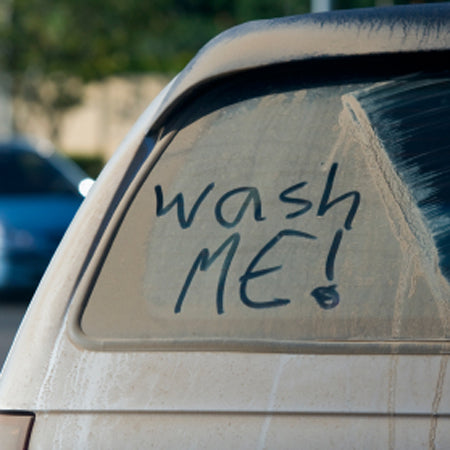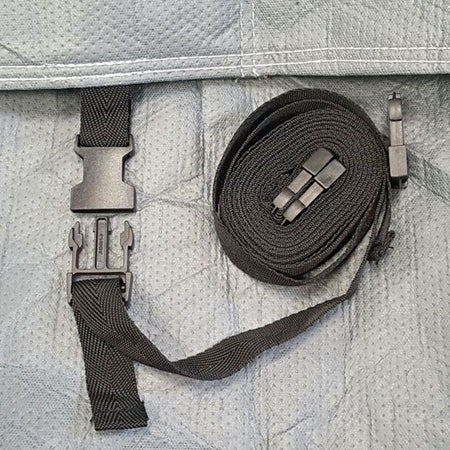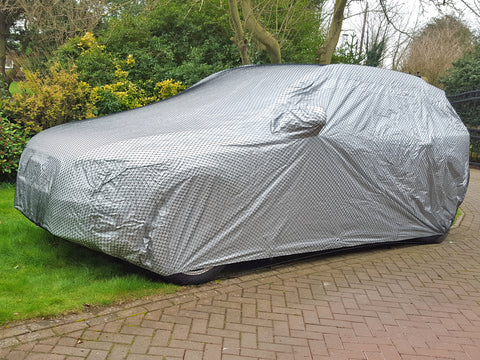How to use a car cover
You may think this is a simple procedure and it is but like everything in life if you have a bit of relevant information the job gets easier.
If you are reading this and you have not purchased from ourselves don't worry a lot of the points I'm about to cover will be valid for most car covers.
The most important point I can stress is ALWAYS make sure the car is super clean and free from debris like grit.

Before fitting a car cover your car should be free from dirt and grit
Why? you ask - If you imagine your car covered in small particles of sharp material especially around the front and sides of the car? Now imagine a piece of car cover material rubbing against the grit and grime that in turn is rubbing on your cars paint. Now you have a mark on your pride and joy. This is not the car covers fault but yours for putting a cover on a dirty car!

Never put a car cover on a dirty vehicle
Ok so you want to use your car cover every day, that's fine but you will have to wash your car every day when you return home before fitting the cover. I don't advocate the use of a full car cover to be used every day the only cover that could be used this way would be a Half Size cover. As this is covering mostly the glass and roof area you should be ok but always make sure it's not too bad before fitting.
Fitting a car cover, a few tips here. Don't let the car cover touch the ground as you will pick up dirt, potentially this could get between the car cover and the car, more scratches!
This next bit works best when the cover has been on the car once already as you need to perform the technique in reverse taking note of the front of the cover.
Place the cover in the middle of the roof and roll out to the bonnet, then to the boot. Pull down the sides and place the mirrors in pockets if you have them, do this both sides. Pull the front of the cover over the bumper and again over the rear bumper. Check the cover is pulled down all the way around the car. Now attach the under body straps, but not too tight. When taking the cover off the car try to do the removal as described above but in reverse, this way you will have a manageable car cover next time you refit.
Another area that many car cover users fall down is the securing straps (under body straps), normally a couple of straps run under the car from left to right. The idea is to stop the cover from lifting in strong winds, that said I have seen the under body straps so tight they have parted company with the cover itself. Don't over tighten the straps they are there to stop the cover lifting away not for clamping the cover to car so it cannot move. Sometimes getting the straps under the car can be difficult especially if the car is low to the ground and on grass. Two ways I have found works the best. Attach the end of the strap to a length of wooden bamboo cane with an elastic band. You can now push the strap under the car with ease. Another way is to attach the strap to an old tennis ball and throw the ball under the car, both ideas work well.

Underbody straps help to keep a car cover in place
How do I clean my car cover? Depending on your brand of cover you might be able to pop it into a washing machine, low heat with little or no detergent. You will need to ask your supplier first. The problem is most car covers have a lot of fabric and most washing machines are too small to do the job.
Another way that I think is better is to wash the cover on the car! The cover will hold its shape while you wash off the rubbish, again warm water with little or no detergent, wash off any excess soap completely . Once clean leave to dry so I would pick a nice warm sunny day to do this job.
The inside should not be dirty but if you need to clean it then you could turn the cover inside out, place it on the car and clean in the same way. Just be very careful keeping the cover off the ground, I would always use two people to do this procedure.
When using a car cover its not meant to be used in very strong winds, this will depend on your brand of cover and type but we always say no more that 60 MPH.

During windy conditions it is always best to use extra straps or a car cover net
So now you have a problem! you are away on business or holiday and a storm hits your home and your car cover is likely to be blown away! Some covers have extra eyelets front and rear, this enables you to attach a small diameter rope or similar to the front of the cover. Run under the length of the car and attach to the rear eyelet thus holding the front and rear sections of the car cover under the car.
You don't have extra eyelets? In this case we offer a Car Cover Net, this is a netting that is placed over the car cover and holds the cover in place against the car. The bottom hem has a bungee cord running the complete circumference of the car helping hold the netting in place. Great solution to a potential problem.
You want to tow your car, OK but you want to keep it clean and dirt free. If you had asked this question a year ago I would have said we cannot help as we don't advocate the use of car covers being towed behind vehicles at speeds, it is dangerous. But a year on and we can say we can help by using our Car Cover Net.

Car Cover Net fitted to a SummerPRO cover. Ideal in windy areas, can also be used when towing vehicles
Because we use this in high wind situations it lends its self to the towing of car with car covers fitted. I would always suggest the SummerPRO car cover used in conjunction with the Car Cover Net , the SummerPRO has good tear resistance qualities in the first place so makes it the ideal partner with the Car Cover Net.
For more information about the Car Cover Net or any other question you may have about any of our products please feel free to contact us.
Blog Disclaimer

Comments
Duncan Lance:
A car cover can be a real benefit to any car owner, but you really do need to know how to take care of it. I do like that the article goes over whether or not a car cover can go in the wash. After all, that can make cleaning it much more simple, so it is something to look into. https://www.corvettepartsandaccessories.com/collections/corvette-car-covers
Sep 06, 2025
Leave a comment